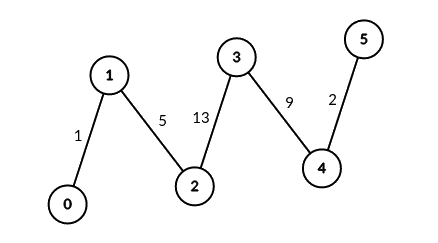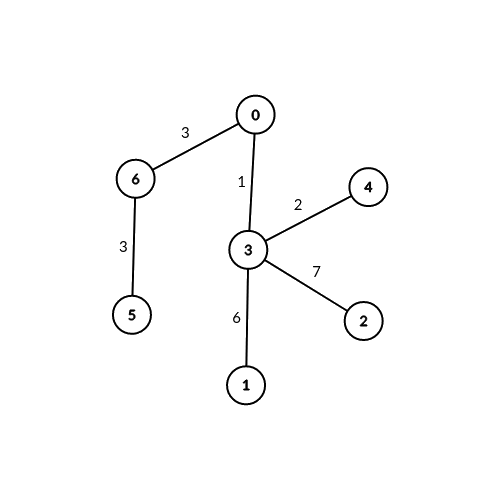| comments | difficulty | edit_url | rating | source | tags | |||
|---|---|---|---|---|---|---|---|---|
true |
Medium |
1908 |
Biweekly Contest 125 Q3 |
|
You are given an unrooted weighted tree with n vertices representing servers numbered from 0 to n - 1, an array edges where edges[i] = [ai, bi, weighti] represents a bidirectional edge between vertices ai and bi of weight weighti. You are also given an integer signalSpeed.
Two servers a and b are connectable through a server c if:
a < b,a != candb != c.- The distance from
ctoais divisible bysignalSpeed. - The distance from
ctobis divisible bysignalSpeed. - The path from
ctoband the path fromctoado not share any edges.
Return an integer array count of length n where count[i] is the number of server pairs that are connectable through the server i.
Example 1:
Input: edges = [[0,1,1],[1,2,5],[2,3,13],[3,4,9],[4,5,2]], signalSpeed = 1 Output: [0,4,6,6,4,0] Explanation: Since signalSpeed is 1, count[c] is equal to the number of pairs of paths that start at c and do not share any edges. In the case of the given path graph, count[c] is equal to the number of servers to the left of c multiplied by the servers to the right of c.
Example 2:
Input: edges = [[0,6,3],[6,5,3],[0,3,1],[3,2,7],[3,1,6],[3,4,2]], signalSpeed = 3 Output: [2,0,0,0,0,0,2] Explanation: Through server 0, there are 2 pairs of connectable servers: (4, 5) and (4, 6). Through server 6, there are 2 pairs of connectable servers: (4, 5) and (0, 5). It can be shown that no two servers are connectable through servers other than 0 and 6.
Constraints:
2 <= n <= 1000edges.length == n - 1edges[i].length == 30 <= ai, bi < nedges[i] = [ai, bi, weighti]1 <= weighti <= 1061 <= signalSpeed <= 106- The input is generated such that
edgesrepresents a valid tree.
First, we construct an adjacency list g based on the edges given in the problem, where g[a] represents all the neighbor nodes of node a and their corresponding edge weights.
Then, we can enumerate each node a as the connecting intermediate node, and calculate the number of nodes t that start from the neighbor node b of a and whose distance to node a can be divided by signalSpeed through depth-first search. Then, the number of connectable node pairs of node a increases by s * t, where s represents the cumulative number of nodes that start from the neighbor node b of a and whose distance to node a cannot be divided by signalSpeed. Then we update s to s + t.
After enumerating all nodes a, we can get the number of connectable node pairs for all nodes.
The time complexity is
class Solution:
def countPairsOfConnectableServers(
self, edges: List[List[int]], signalSpeed: int
) -> List[int]:
def dfs(a: int, fa: int, ws: int) -> int:
cnt = 0 if ws % signalSpeed else 1
for b, w in g[a]:
if b != fa:
cnt += dfs(b, a, ws + w)
return cnt
n = len(edges) + 1
g = [[] for _ in range(n)]
for a, b, w in edges:
g[a].append((b, w))
g[b].append((a, w))
ans = [0] * n
for a in range(n):
s = 0
for b, w in g[a]:
t = dfs(b, a, w)
ans[a] += s * t
s += t
return ansclass Solution {
private int signalSpeed;
private List<int[]>[] g;
public int[] countPairsOfConnectableServers(int[][] edges, int signalSpeed) {
int n = edges.length + 1;
g = new List[n];
this.signalSpeed = signalSpeed;
Arrays.setAll(g, k -> new ArrayList<>());
for (var e : edges) {
int a = e[0], b = e[1], w = e[2];
g[a].add(new int[] {b, w});
g[b].add(new int[] {a, w});
}
int[] ans = new int[n];
for (int a = 0; a < n; ++a) {
int s = 0;
for (var e : g[a]) {
int b = e[0], w = e[1];
int t = dfs(b, a, w);
ans[a] += s * t;
s += t;
}
}
return ans;
}
private int dfs(int a, int fa, int ws) {
int cnt = ws % signalSpeed == 0 ? 1 : 0;
for (var e : g[a]) {
int b = e[0], w = e[1];
if (b != fa) {
cnt += dfs(b, a, ws + w);
}
}
return cnt;
}
}class Solution {
public:
vector<int> countPairsOfConnectableServers(vector<vector<int>>& edges, int signalSpeed) {
int n = edges.size() + 1;
vector<pair<int, int>> g[n];
for (auto& e : edges) {
int a = e[0], b = e[1], w = e[2];
g[a].emplace_back(b, w);
g[b].emplace_back(a, w);
}
function<int(int, int, int)> dfs = [&](int a, int fa, int ws) {
int cnt = ws % signalSpeed == 0;
for (auto& [b, w] : g[a]) {
if (b != fa) {
cnt += dfs(b, a, ws + w);
}
}
return cnt;
};
vector<int> ans(n);
for (int a = 0; a < n; ++a) {
int s = 0;
for (auto& [b, w] : g[a]) {
int t = dfs(b, a, w);
ans[a] += s * t;
s += t;
}
}
return ans;
}
};func countPairsOfConnectableServers(edges [][]int, signalSpeed int) []int {
n := len(edges) + 1
type pair struct{ x, w int }
g := make([][]pair, n)
for _, e := range edges {
a, b, w := e[0], e[1], e[2]
g[a] = append(g[a], pair{b, w})
g[b] = append(g[b], pair{a, w})
}
var dfs func(a, fa, ws int) int
dfs = func(a, fa, ws int) int {
cnt := 0
if ws%signalSpeed == 0 {
cnt++
}
for _, e := range g[a] {
b, w := e.x, e.w
if b != fa {
cnt += dfs(b, a, ws+w)
}
}
return cnt
}
ans := make([]int, n)
for a := 0; a < n; a++ {
s := 0
for _, e := range g[a] {
b, w := e.x, e.w
t := dfs(b, a, w)
ans[a] += s * t
s += t
}
}
return ans
}function countPairsOfConnectableServers(edges: number[][], signalSpeed: number): number[] {
const n = edges.length + 1;
const g: [number, number][][] = Array.from({ length: n }, () => []);
for (const [a, b, w] of edges) {
g[a].push([b, w]);
g[b].push([a, w]);
}
const dfs = (a: number, fa: number, ws: number): number => {
let cnt = ws % signalSpeed === 0 ? 1 : 0;
for (const [b, w] of g[a]) {
if (b != fa) {
cnt += dfs(b, a, ws + w);
}
}
return cnt;
};
const ans: number[] = Array(n).fill(0);
for (let a = 0; a < n; ++a) {
let s = 0;
for (const [b, w] of g[a]) {
const t = dfs(b, a, w);
ans[a] += s * t;
s += t;
}
}
return ans;
}
